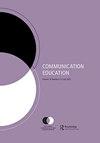K-12的沟通教学:我们的责任、挑战和“把罐子踢到路边”的倾向
IF 0.8
Q3 COMMUNICATION
引用次数: 0
摘要
这三篇文章回应了我们早期关于K-12教育系统中沟通教育现状的刺激性文章(Yastremski&Morreale,2021),呼吁人们注意全国范围内沟通学科的一种趋势,即“把这个罐子踢到路边”,支持其他感兴趣的优先领域。这种趋势可能与传播的普遍性有关,这导致了传播教师学者和我们的主要学术组织国家传播协会(NCA)的多个主题优先事项。与此同时,这些文章还呼吁人们注意该学科在K-12学校负责和支持沟通教学的历史授权,一些人说这些授权基本上被忽视了(Book,1989;Hunt等人,2014;Rudick和Dannels,2020)。也就是说,这些文章指出,随着时间的推移,K-12在学科内部和外部的沟通方面做出了一些有价值的努力。为了说明这一点,NCA过去曾采取措施,为K-12教育提供以学科为中心、以研究为导向的方法。1996年,该协会制定了《口语、听力和媒体素养标准》,并于1998年发布(国家传播协会,2022年)。2005年,在成员们的贡献和支持下,该组织批准了《大学成功的大学董事会标准:英语语言艺术》,以取代NCA标准。大学理事会标准仍然是NCA对K-12沟通教育的定义,尽管大学理事会已经将文件和计划存档,NCA也没有努力更新或修订标准。然后,在2017年,NCA立法议会通过了一项修订决议,批准将沟通教育纳入全国中学所有学生的毕业要求,并强调使用经过适当培训的教师教授沟通教育的重要性。该决议还呼吁该协会为NCA提供一个议程,以促进K-12沟通教育倡议。到目前为止,NCA尚未对该决议采取任何重大行动。该学科之外的其他机构和组织意识到K-12对沟通教学的必要性,做出了宝贵的贡献,其中最重要的是共同核心国家标准(20152022)。本文章由计算机程序翻译,如有差异,请以英文原文为准。
Teaching and learning about communication in K-12: our responsibilities, challenges, and tendency to “kick the can to the side of the road”
The three essays responding to our earlier stimulus essay on the status of communication education in the K-12 educational system (Yastremski &Morreale, 2021) call attention to a tendency in the communication discipline nationally to “kick this can to the side of the road,” in favor of other priority areas of interest. This tendency possibly relates to the ubiquitous nature of communication, which results in a multiplicity of topical priorities for communication teacher-scholars and our leading academic organization, the National Communication Association (NCA). At the same time, the essays also call attention to historical mandates for the discipline to take responsibility for and support teaching and learning about communication in K-12 schools, mandates that some say have largely gone unheeded (Book, 1989; Hunt et al., 2014; Rudick & Dannels, 2020). That said, the essays point to some valuable efforts about communication in K-12 over time, both within the discipline and externally. To illustrate, NCA has taken steps in the past to inform a discipline-centered and research-driven approach to K-12 education. In 1996, the association created Speaking, Listening, and Media Literacy Standards, which were published in 1998 (National Communication Association, 2022). In 2005, with members’ contributions and support, the organization endorsed the College Board Standards for College Success: English Language Arts, as a replacement for the NCA standards. The College Board standards continue to serve as NCA’s definition for K-12 communication education, although the College Board has since archived the document and program, and NCA has not endeavored to update or revise the standards. Then, in 2017, the NCA Legislative Assembly passed a revised resolution that endorsed the inclusion of communication education as a graduation requirement for all students in the nation’s secondary schools and stressed the importance of using appropriately trained teachers to teach communication education. The resolution also called on the association to provide an agenda for NCA to promote a K-12 communication education initiative. To date, NCA has not acted on that resolution in any significant manner. Other agencies and organizations external to the discipline, aware of the K-12 imperative for communication instruction, have made valuable contributions, most significant of which are the Common Core State Standards (2015, 2022).
求助全文
通过发布文献求助,成功后即可免费获取论文全文。
去求助
来源期刊

COMMUNICATION EDUCATION
EDUCATION & EDUCATIONAL RESEARCH-
CiteScore
3.10
自引率
34.80%
发文量
47
期刊介绍:
Communication Education is a peer-reviewed publication of the National Communication Association. Communication Education publishes original scholarship that advances understanding of the role of communication in the teaching and learning process in diverse spaces, structures, and interactions, within and outside of academia. Communication Education welcomes scholarship from diverse perspectives and methodologies, including quantitative, qualitative, and critical/textual approaches. All submissions must be methodologically rigorous and theoretically grounded and geared toward advancing knowledge production in communication, teaching, and learning. Scholarship in Communication Education addresses the intersections of communication, teaching, and learning related to topics and contexts that include but are not limited to: • student/teacher relationships • student/teacher characteristics • student/teacher identity construction • student learning outcomes • student engagement • diversity, inclusion, and difference • social justice • instructional technology/social media • the basic communication course • service learning • communication across the curriculum • communication instruction in business and the professions • communication instruction in civic arenas In addition to articles, the journal will publish occasional scholarly exchanges on topics related to communication, teaching, and learning, such as: • Analytic review articles: agenda-setting pieces including examinations of key questions about the field • Forum essays: themed pieces for dialogue or debate on current communication, teaching, and learning issues
 求助内容:
求助内容: 应助结果提醒方式:
应助结果提醒方式:


